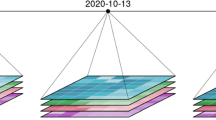Abstract
In this paper, we present the Pipeline for Observational Data Processing, Analysis, and Collaboration (PODPAC) software. PODPAC is an open-source Python library designed to enable widespread exploitation of NASA earth science data by enabling multi-scale and multi-windowed access, exploration, and integration of available earth science datasets to support analysis and analytics; automatic accounting for geospatial data formats, projections, and resolutions; simplified implementation and parallelization of geospatial data processing routines; standardized sharing of data and algorithms; and seamless transition of algorithms and data products from local development to distributed, serverless processing on commercial cloud computing environments. We describe the key elements of PODPAC’s architecture, including Nodes for unified encapsulation of disparate scientific data sources; Algorithms for plug-and-play processing and harmonization of multiple data source Nodes; and Lambda functions for serverless execution and sharing of new data products via the cloud. We provide an overview of our open-source code implementation and testing process for development and deployment of PODPAC. We describe our interactive, JupyterLab-based end-user documentation including quick-start examples and detailed use case studies. We conclude with examples of PODPAC’s application to: encapsulate data sources available on Amazon Web Services (AWS) Open Data repository; harmonize processing of multiple earth science data sets for downscaling of NASA Soil Moisture Active Passive (SMAP) soil moisture data; and deploy a serverless SMAP-based drought monitoring application for use access from mobile devices. We postulate that PODPAC will also be an effective tool for wrangling and standardizing massive earth science data sets for use in model training for machine learning applications.









Similar content being viewed by others
Notes
Abbreviations
- AWS:
-
Amazon Web Services.
- CRS:
-
Coordinate Reference System.
- DAAC:
-
Distributed Active Archive Center.
- DEM:
-
Digital Elevation Mode.
- JSON:
-
JavaScript Object Notation.
- NASA:
-
National Aeronautics and Space Administration.
- NSIDC:
-
National Snow and Ice Data Center.
- PODPAC:
-
Pipeline for Observational Data Processing Analysis and Collaboration.
- SMAP:
-
Soil Moisture Active Passive.
- TWI:
-
Topographic Wetness Index.
- WCS:
-
Web Coverage Service.
- WMS:
-
Web Mapping Service.
References
Bavoil L, Callahan S, Scheidegger C, Vo H, Crossno P, Silva C, Freire J (2005). Vistrails: enabling interactive multiple-view visualizations. IEEE visualization 135–142
Beven KJ, Kirkby MJ, Schofield N, Tagg AF (1984) Testing a physically-based flood forecasting model (TOPMODEL) for three UK catchments. Journal of Hydrology, 10 69(1–4):119–143
Cowart, C, Block, J, Crawl, D, Graham, J, Gupta, A, Nguyen de Callafon, M R Smarr L and Altintas, I (2015). geoKepler Workflow Module for Computationally Scalable and Reproducible Geoprocessing and Modeling. AGUFM, 2015, NH43B-1887
Mehrotra, P, Pryor, LH., Bailey RF. and Cotnoir, M (2014). NASA technical report NAS-2014-02. NASA Ames, Moffett Field, CA. http://www.nas.nasa.gov/assets/pdf/papers/NAS_Technical_Report_NAS-2014-02.pdf. Accessed 12 August 2020
Missier P, Soiland-Reyes S, Owen S, Tan W, Nenadic A, Dun-lop I, Williams A, Oinn T, Goble CA. (2010). Taverna, reloaded. SSDBM, 471–481
Read JS, Walker JI, Appling AP, Blodgett DL, Read EK, Winslow LA (2016) Geoknife: reproducible web-processing of large gridded datasets. Ecography 39(4):354–360
Yin D, Liu Y, Hu H, Terstriep J, Hong X, Padmanabhan A, Wang S (2019) CyberGIS-Jupyter for reproducible and scalable geospatial analytics. Concurrency and Computation: Practice and Experience 31(11):e5040
Zhang, M, & Yue, P (2013). GeoJModelBuilder: a java implementation of model-driven approach for geoprocessing workflows. In 2013 second international conference on agro-Geoinformatics (agro-Geoinformatics) (pp. 393-397). IEEE
Acknowledgements
This research is supported by NASA under SBIR Phase II Contract No. 80NSSC18C0061. We gratefully acknowledge the developers of the open source software libraries on which PODPAC depends, in particular Anaconda, GDAL, JupyterLab, numpy, proj4J, rasterio, scipy and xarray. The SMAP data used in this study can be downloaded from https://nsidc.org/data/smap/smap-data.html. The global digital elevation model (DEM) data used in this study can be downloaded from http://viewfinderpanoramas.org/dem3.html. The TWI data used in this study can be downloaded via WCS from https://mobility.crearecomputing.com/ogc?
Author information
Authors and Affiliations
Corresponding author
Additional information
Publisher’s note
Springer Nature remains neutral with regard to jurisdictional claims in published maps and institutional affiliations.
Rights and permissions
About this article
Cite this article
Ueckermann, M.P., Bieszczad, J., Entekhabi, D. et al. PODPAC: open-source Python software for enabling harmonized, plug-and-play processing of disparate earth observation data sets and seamless transition onto the serverless cloud by earth scientists. Earth Sci Inform 13, 1507–1521 (2020). https://doi.org/10.1007/s12145-020-00506-0
Received:
Accepted:
Published:
Issue Date:
DOI: https://doi.org/10.1007/s12145-020-00506-0




